What Is Bitcoin Halving? Definition How It Works? Halving the reward for mining is a crucial occurrence on the Bitcoin network. Each block mined successfully since 2020 has earned the network participants that validate transactions of 6.25 bitcoins (BTC).
The block reward is anticipated to decrease to 3.125 in early to mid-2024, marking the next halving. As the block reward gets closer to one satoshi, the effect of each halving will gradually fade.
KEY TAKEAWAYS
- It’s a halving event when Bitcoin’s mining reward is slashed in half.
- Halvings reduce the amount of newly minted coins because the rate of currency creation is reduced.
- The previous Bitcoin halving occurred on May 11, 2020, yielding a 6.25 BTC block reward.
- When there are 21 million bitcoins in circulation, the theoretical maximum supply, the final halving is anticipated to take place around 2140.1
Basics of the Bitcoin Network

One must be familiar with the inner workings of the Bitcoin network to grasp the concept of a Bitcoin halving.
Blockchain, the technology behind Bitcoin, is a decentralized ledger that records all or part of the transactions that have taken place on the network. This ledger is maintained by a network of computers, or nodes, that run the Bitcoin software. It is the responsibility of every full node, which is a node that contains the complete history of Bitcoin transactions, to approve or reject a transaction on the Bitcoin network. The node verifies the legitimacy of the transaction to accomplish this. You should check that the transaction is short and has the proper validation settings. We review and approve each transaction separately. This is said to happen alone once every transaction in a block has been approved. After approval, the transaction is broadcast to other nodes and added to the current blockchain.2
The reliability and safety of the blockchain are enhanced as its number of computers, or nodes, grows. It is believed that 16,902 nodes are currently operating Bitcoin code as of November 1, 2023.3 Anyone with sufficient storage can become a node in the Bitcoin network and access the whole blockchain and transaction history; however, not everyone with this capability is a miner.
Basics of Bitcoin Mining

One must be familiar with the inner workings of the Bitcoin network to grasp the concept of a Bitcoin halving.
Blockchain, the technology behind Bitcoin, is a decentralized ledger that records all or part of the transactions that have taken place on the network. This ledger is maintained by a network of computers, or nodes, that run the Bitcoin software. It is the responsibility of every full node, which is a node that contains the complete history of Bitcoin transactions, to approve or reject a transaction on the Bitcoin network. The node verifies the legitimacy of the transaction to accomplish this. You should check that the transaction is short and has the proper validation settings. We review and approve each transaction separately. This is said to happen alone once every transaction in a block has been approved. After approval, the transaction is broadcast to other nodes and added to the current blockchain.2
The reliability and safety of the blockchain are enhanced as its number of computers, or nodes, grows. It is believed that 16,902 nodes are currently operating Bitcoin code as of November 1, 2023.3 Anyone with sufficient storage can become a node in the Bitcoin network and access the whole blockchain and transaction history; however, not everyone with this capability is a miner.
What Is Bitcoin Halving?

Bitcoin miners get half the block reward for processing transactions after the network mines 210,000 blocks every four years. This occurrence is dubbed halving because it decreases the rate of new bitcoins issued into circulation in half.
When the projected maximum of 21 million coins is achieved, this rewards system will end around 2140. Network users will then pay fees to miners in exchange for their services in processing transactions. These fees ensure miners are still incentivized to join and maintain the network.
The halving event is an important reason why the rate of new Bitcoins produced is dropping as it approaches its finite quantity. Fifty bitcoins were rewarded for mining a single block in the 2009 blockchain. In October 2023, there were approximately 19.5 million bitcoins in circulation, with just about 1.5 million remaining to be released through mining awards.5
When Did the Bitcoin Halvings Happen?
By October 2023, there have been three splits:
- Nov. 28, 2012, to 25 bitcoins
- July 9, 2016, to 12.5 bitcoins
- May 11, 2024, to 6.25 bitcoins1
What Happens When Bitcoin Halves?
In the context of Bitcoin, the word “halving” refers to the distribution of reward tokens. With the hope of increasing demand, this serves as a model of decreasing returns.
Why Are the Halvings Occurring Less Than Every 4 Years?
According to the Bitcoin mining algorithm, new blocks should be discovered every ten minutes. 6 Some blocks can take more than 10 minutes and less for others. Depending on this, it may take more or less time to reach the next halving objective. The 210,000 blocks needed would take approximately 1,409 days to mine if blocks were mined at an average of 9.66 minutes each. This is based on a four-year calculation for one extra day for a leap year.7
What Happens When There Are No More Bitcoins Left?
The last bitcoin is widely believed to have been mined in 2140. Nevertheless, the prize will gradually decrease until it reaches one satoshi if cut in half every 210,000 blocks. The smallest unit of bitcoin, the satoshi, is 0.00000001 bitcoin and cannot be divided in half. After 2140, the reward might be in the millions of satoshi, but it could stay at one satoshi until the total number of bitcoins equals 21 million.
The Bottom Line
However, halving the Bitcoin supply would reduce the rate of new releases by half. The planned limit of 21 million bitcoins is theoretically achieved in 2140, after which the rewards system is anticipated to end.
Fifty bitcoins were rewarded for mining a single block in the 2009 blockchain. Following the initial halving, it was 25, then 12.5, and finally, as of May 11, 2020, 6.25 bitcoins per block. The network is significantly affected by the Bitcoin halving. As smaller mining operations and individuals leave the industry or are acquired by bigger ones, the halving event could consolidate the mining community.


